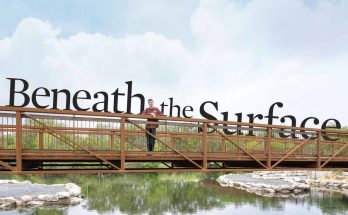“If You Don’t Already Live in a Sponge City, You Will Soon”
WIRED, October 17, 2022
Science
By Matt Simon
“Less pavement and more green spaces help absorb water instead of funneling it all away—a win-win for people and urban ecosystems.”
Like anything else, water is great in moderation—urbanites need it to survive, but downpours can flood streets and homes. And as you might have noticed, climate change isn’t good at moderation. A warmer atmosphere holds more moisture, supercharging storms to dump more water quicker, which can overwhelm municipal sewer systems built for the climate of long ago. Thus you get the biblical flooding that’s been drowning cities around the world, from Zhengzhou, China, to Seoul, South Korea, to Cologne, Germany, to New York City.
In response, urban planners are increasingly thinking of cities less as rain jackets—designed to whisk water away as fast as possible before it has a chance to accumulate—and more as sponges. By deploying thirsty green spaces and digging huge dirt bowls where water can gather and percolate into underlying aquifers, “sponge cities” are making rain an asset to be exploited instead of expelled.
“The denser cities are developed, the more impervious surfaces are used, the worse the impacts of climate change are becoming,” Kiparsky continues. “Once the capacity of these structures is exceeded, then water starts backing up, and its problems are exacerbated because of the lack of the natural absorbency of large areas of soil and vegetation.”
Any good city planner knows the value of green spaces, but traditionally these have been used mainly for public enjoyment. Sponge city designers also use them as a tool for managing increasingly furious rainstorms. An inch of rain dumped over the course of an hour is more likely to overwhelm stormwater infrastructure than the same inch of water falling over 24 hours—a problem for places like in Pittsburgh, Pennsylvania, where storms have gotten significantly wetter over the past half century. “The long and short of it is: more intense and more frequent,” says Tony Igwe, senior group manager of stormwater at the Pittsburgh Water and Sewer Authority, which is sponge-ifying the city. “There’s a lot of work going on not just in Pittsburgh, but especially in the mid-Atlantic, to really look at those numbers in the next few years.”
One of the ways Pittsburgh is tackling this new reality is with a more permeable surface (shown above) made of concrete bricks. The trick is that the small gaps between the blocks are filled with crushed stone, which allows water to trickle down between them. This kind of pavement can be deployed where greenery can’t, like alleys and parking lanes.
But where greenery can go, Pittsburgh and other cities are also deploying the humble rain garden, a simple plot of vegetation on a property or roadside that captures water washed off the street. Yet another option is building what’s called “vegetated swales”: essentially ditches filled with grass and other plants that gather stormwater and help it seep into the ground. Engineers can further expand a green space’s water-absorbing powers with special modules that look like milk crates, which provide empty space underground for the rainwater to fill.
About the Author:
Matt Simon is a science journalist at WIRED, where he covers biology, robotics, cannabis, and the environment. He’s also the author of “Plight of the Living Dead: What Real-Life Zombies Reveal About Our World—And Ourselves,” and “The Wasp That Brainwashed the Caterpillar,” which won an Alex Award.
See also:
- Utah Museum of Natural History, Parking lot made of pervious concrete as an example of sponge-ifying an urban environment.
- “Pervious Pavement” – National Ready Mixed Concrete Association



